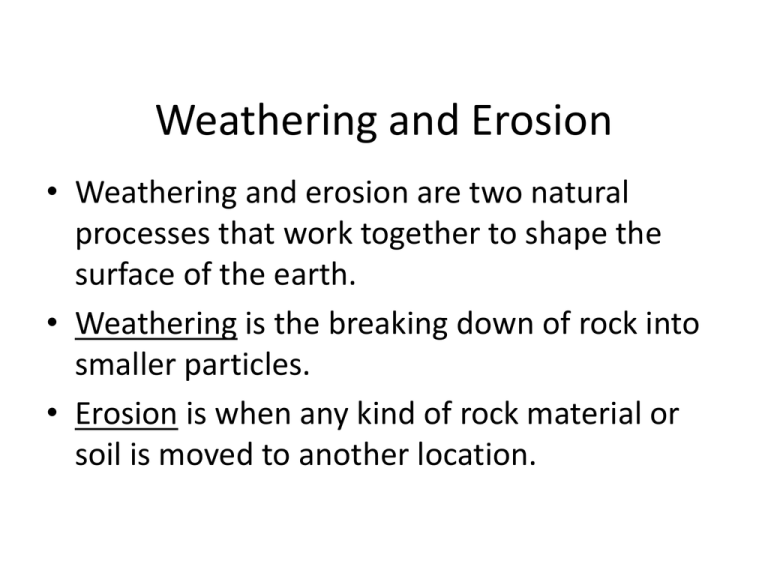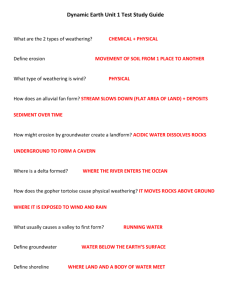Erosion and weathering
advertisement

Weathering and Erosion • Weathering and erosion are two natural processes that work together to shape the surface of the earth. • Weathering is the breaking down of rock into smaller particles. • Erosion is when any kind of rock material or soil is moved to another location. What do you think contributed to the formation of this? Can you see evidence of weathering and erosion taking place here? Two types of Weathering 1. Mechanical weathering is when rocks are broken in smaller pieces by a physical force Abrasion: when rocks knock or scrape against each other Abrasion: mechanical weathering Which rocks are you more likely to find on a river bed? Why? Two types of Weathering 1. Mechanical weathering is when rocks are broken in smaller pieces by a physical force Abrasion: when rocks knock or scrape against each other Ice wedging: when water in cracks freezes and causes rocks to split Ice wedging Two types of Weathering 1. Mechanical weathering is when rocks are broken in smaller pieces by a physical force Abrasion: when rocks knock or scrape against each other Ice wedging: when water in cracks freezes and causes rocks to split Plant action: when plant roots grow into rocks and cause them to crack and split Weathering by plants Two types of Weathering 1. Mechanical weathering is when rocks are broken in smaller pieces by a physical force Abrasion: when rocks knock or scrap against each other Ice wedging: when water in cracks freezes and causes rocks to split Plant action: when plant roots grow into rocks and cause them to crack and split 2. Chemical weathering wears away rock by chemical reaction Two types of Weathering 1. Mechanical weathering is when rocks are broken in smaller pieces by a physical force Abrasion: when rocks knock or scrape against each other Ice wedging: when water in cracks freezes and causes rocks to split Plant action: when plant roots grow into rocks and cause them to crack and split 2. Chemical weathering wears away rock by chemical reaction Dissolving by acid Dissolving by acid Remember our acid test? What was happening to our rocks? Stalactites Stalagmite Acid rain from pollution Two types of Weathering 1. Mechanical weathering is when rocks are broken in smaller pieces by a physical force Abrasion: when rocks knock or scrap against each other Ice wedging: when water in cracks freezes and causes rocks to split Plant action: when plant roots grow into rocks and cause them to crack and split 2. Chemical weathering wears away rock by chemical reaction Dissolving by acid Oxidation (rusting) Chemical weathering Oxidation Weathering and Erosion • Weathering and erosion are two natural processes that work together to shape the surface of the earth. • Weathering is the breaking down of rock into smaller particles. • Erosion is when any kind of rock material or soil is moved to another location. Erosion (moving of rock and soil) • What can move rock and soil from one place to another? Erosion (moving of rock and soil) • What can move rock and soil from one place to another? Moving water; rain runoff, rivers, oceans etc. Erosion (moving of rock and soil) • What can move rock and soil from one place to another? Moving water; rain runoff, rivers, oceans etc. Wind; can carry sand, dust and soil Erosion (moving of rock and soil) • What can move rock and soil from one place to another? Moving water; rain runoff, rivers, oceans etc. Wind; can carry sand, dust and soil Ice; glaciers and icebergs Erosion (moving of rock and soil) • What can move rock and soil from one place to another? Moving water; rain runoff, rivers, oceans etc. Wind; can carry sand, dust and soil Ice; glaciers and icebergs Gravity; mudslides, landslides and gradual creep Gravity is the underlying force of erosion Gravity Sudden landslide Gradual creep Erosion (moving of rock and soil) • What can move rock and soil from one place to another? Moving water; rain runoff, rivers, oceans etc. Wind; can carry sand, dust and soil Ice; glaciers and icebergs Gravity; mudslides and landslides Gravity is the underlying force of erosion • Deposition: when rock or soil is dropped in a new place. Can you see evidence of weathering and erosion here? How might this rock have formed cracks? Describe how these gravestones probably look different from when they were carved? What do you think is responsible for these changes? Homework • Describe 4 ways that nature can break down rocks into smaller pieces.




